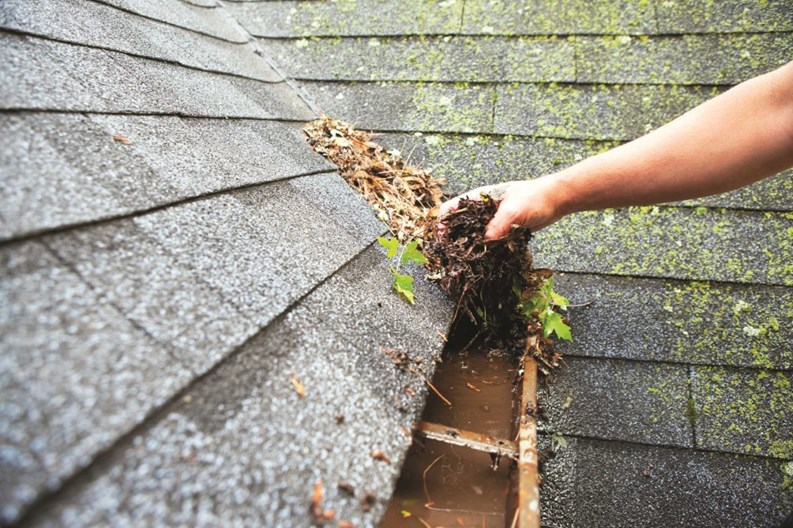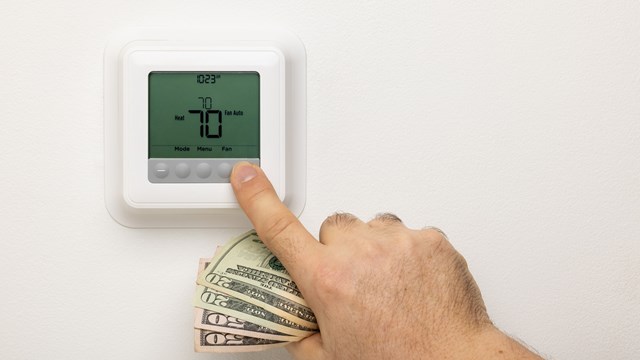It’s not easy being a co-op or condo building in New Jersey in winter. Freezing rain and wind beat relentlessly at the façade. Snow accumulates on the roof, turns to ice, and when it thaws, seeps into units below. Systems in the building work double-time to keep home-bound residents warm and cozy.
Now, with the first days of spring around the corner, it’s time to take stock of any damage the winter has done and launch a spring cleaning and repair program.
It’s What’s Outside that Counts
Best done in early March, a springtime inspection on a high-rise co-op or low-rise condo or townhouse works from the outside in—and most managers agree the the first order of business is a comprehensive evaluation of the exterior envelope. An important initial point of any inspection is simply to check the perimeter of the building, especially the roof for any material that might be unsecured or loose due to any harsh winter winds.
It's necessary to find any possible areas of penetration for water, the primary enemy of any building structure. In winter, freezing temperatures will cause any moisture in metal and brick elements to expand, which can cause cracks and ruptures.
Points of particular concern are areas where two different types of materials meet, like limestone and brick, for example, or concrete and metal. The difference in physical properties causes different reactions to the elements, and that differing movement can cause cracks, the initial symptom of any structural problem down the road.
You don't need an advanced degree to spot problems in a building: gaps, cracks, fissures, blisters, buckles, flaking, can allow moisture to seep into a co-op, condo or HOA unit. The edges of doors and windows, anything that penetrates the exterior, tend to be the biggest culprits of cracks and deficiencies.
Don’t Crack Up
To the layman, a little crack can seem pretty innocuous. But, just one crack in the wall of one floor can lead to a flood downstairs after just one heavy rainfall. Minor cracks in the façade can be treated with silicone—a simple, but temporary, solution. But in older buildings, aging bricks might have to be replaced and repointed.
To gauge the extent of repair that needs to be made on a particular crack or fissure in a façade or on a roof, maintenance personnel and managers may want to keep a photographic record to show any inconsistencies over time.
To access damage to the façade that might not register on a visual inspection, it's not a bad idea to reach out to the residents themselves, suggests Jeff Heidings, the president of Siren Management, a management firm based in New York City. “Some diligent managers have their supers go around the building or send out a questionnaire to people after the winter, asking if they see any signs of water penetration,” in their units, he says.
Drains and the Rain
The next stop is the rooftop. “Low temperatures in the winter can cause cracks in the roofing cement if you are not careful about patching cracks the rest of the year,” says Enes Radoncic, a New York City-based superintendent. The main culprit is snow, which can pile high and then melt slowly when temperatures edge above freezing. “Water seeps under the concrete,” he explains, “and leaks into the ceilings below.”
With a single blister or crack on the roof covering, the solution is simple and cheap, says Wayne Bellet, owner of Bellet Construction, a tri-state region exterior maintenance contractor. Cut it out, dry the area and patch it, he says. “But if you call me in three, six or eight months and have two more blisters, you've got to take the gun out and shoot the horse.” In other words, it’s time to replace the roof.
While you’re up on the roof, Heidings advises, “Check the parapet walls and coping stones, and the joints of the coping stones to see if there are any expansion or contraction cracks.” Parapet walls are expensive to repair and should be monitored and maintained regularly throughout the year.
“The spring is also a good time to make sure all your drains are clear of debris,” Heidings says. “A lot of things can happen.”
Low-rise buildings and townhomes often have pitched roofs, gutters and drainage systems that must be cleared of debris and prevented from having any standing water accumulate. Any board member or manager who has experienced drainage problems on their property knows the importance of performing annual maintenance checks on irrigation systems, drainage basins, and even gutters and downspouts attached to buildings themselves. “Before you see the problem is always the best time to do it,” says Paul De Nora, the owner of Advanced Plumbing & Drain Cleaning, Inc. in West Paterson. “We recommend that once a year everything be cleaned and checked to avoid issues later on.”
Maintaining, Grounds, Roads and Pavement
Another part of spring cleaning is an extensive examination of the exterior of the property. A walk-through will identify damage to trees, shrubs, and plantings. Snow plows have been known to damage landscaping and greenery, break tree limbs and topple street signs or mailboxes. The property manager and the building staff will make a checklist of the damage and assess what repairs to undertake around the property.
Certain maintenance items are either the responsibility of the co-op, condo or HOA board or the adjacent township or municipality. New Jersey is made up of 566 municipalities, divided into cities, towns, villages and townships. Current state law allows that certain municipalities can reimburse private communities for services that they provide to the community at large. The Municipal Services Act, enacted in 1993, requires municipalities to reimburse private communities within or adjacent to the townships that pay for certain services. These services include snow and ice removal, electricity costs for street lighting and street collection of recyclables and leaves. Before 1993, there was no reimbursement to communities for these services.
Street paving is not included but New Jersey state Senator James W. Holzapfel introduced legislation (S501) in January of 2014 to amend the act to include it. Although still pending, by virtue of this amendment, New Jersey's municipalities would have to either provide "paving, repaving, or otherwise improving or reimproving" services to a qualified private community, or reimburse that community for its costs (with conditions) to provide those services itself.
Snow and ice removal on association grounds is another tricky subject that can lead to unwanted liability. The association is required to maintain their grounds and in winter this means removing snow and ice within a reasonable time frame. However, according to Attorney Kayci Petenko of the law firm of McGovern Legal Services, LLC in North Brunswick, an association can protect itself from this expense by passing what is called a “Tort Immunity Amendment.” This tort amendment, she says, helps insulate an association from liability in a lawsuit filed by one of its members for a personal injury, such as a slip-and-fall claim. Without this amendment in place, if an owner slips and falls on the association’s common property, the association often times is held liable for damages. This expense is then passed on to all owners through increased insurance premiums, Petenko says.
However, with this amendment, an owner’s ability to be successful in a lawsuit against the association is limited. It is important to note, she adds, that this amendment does not grant the association complete immunity to act without the potential for liability. The association may still be held responsible for any willful, wanton or grossly negligent act or failure to act.
The Air in There
Winter is the season for hunkering down, staying warm and cozy at home. With windows closed, A/C units sealed off, residents tend to cook at home or order out, watch TV, read a book—biding time through the long, cold, dark winter nights until spring comes.
Three or four months with the windows closed and condo units at maximum occupation, as the environmental professionals call it, leaves a toll on heating, ventilation and exhaust systems.
According to Ryan Schneider, managing director of sales at ChuteMaster Environmental Services in Union, “With greater occupation during the winter a number of contaminants and air pollutants, specifically pet dander, dust or even chemicals, are pulled into the HVAC system and re-circulated up to five and seven times a day.”
Even buildings without elaborate HVAC systems recycle contaminants, through bathroom and kitchen exhaust vents and ducts. When the windows are closed, says Schneider, “all the heat and condensation and buildup in the air in the bathroom goes to the path of least resistance: the exhaust vent.”
The building should call in an environmental cleaning professional in the spring to access the health of the ventilation ductwork throughout the buildings and, if necessary, clean the ducts to remove the buildup of contaminants. The professionals use powerful EPA-approved HEPA vacuums to suck up and dispose of fine particles. If clogged, ducts can release contaminated air into the living spaces. And clogged ducts put additional stress on the building’s mechanical exhaust systems.
What Goes Down
Some high-rise buildings may have trash rooms and compacting equipment. According to Bob Frustaci of Premier Compaction Systems, based in Woodland Park, a spring checkup and maintenance call includes a detailed inspection. Workers, said Frustaci, go and inspect every trash door and baffles on every floor and make sure they operate correctly. “With the compactor, we will do preventative maintenance: check the switches, the relays, crack or welds, the oil, the fire suppressant and the equipment that surrounds it. We make sure it is operating to full capacity. We check that there are no hydraulic leaks or wear and tear on metal.”
As with most mechanical systems in the building, adds Frustaci, “If we catch it early enough, you can save thousands.”
Community Cleanup
Springtime is the perfect time to have a Community Cleanup Day, where residents take a hand in minor exterior maintenance and cleaning tasks like painting railings and clearing trash and debris—all the while enjoying a spirit of camaraderie.
And it’s not that New Jerseyans don't take an interest in keeping their grounds neat and beautified, the experts are afraid that it may be a liability issue. “What if somebody's doing something around the building and they get hurt?” asks Heidings. “In co-ops and condos, you do have maintenance committees or house committees from time to time where a couple of people just keep an eye on the house and point things out to management and the board.” And then management gives direction to the staff to address the issues identified.
Leaving spring cleaning to the professionals will make maintenance during the summer and fall a breeze.
Steven Cutler is a freelance writer and a frequent contributor to The New Jersey Cooperator.







Leave a Comment